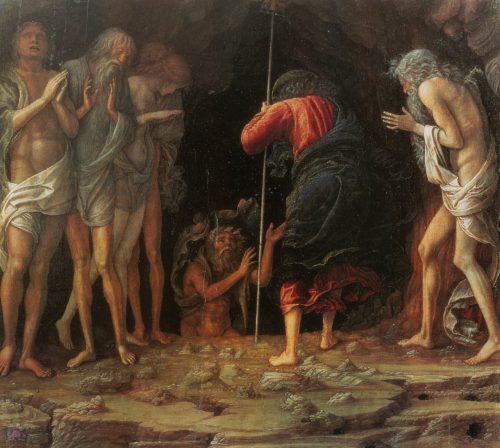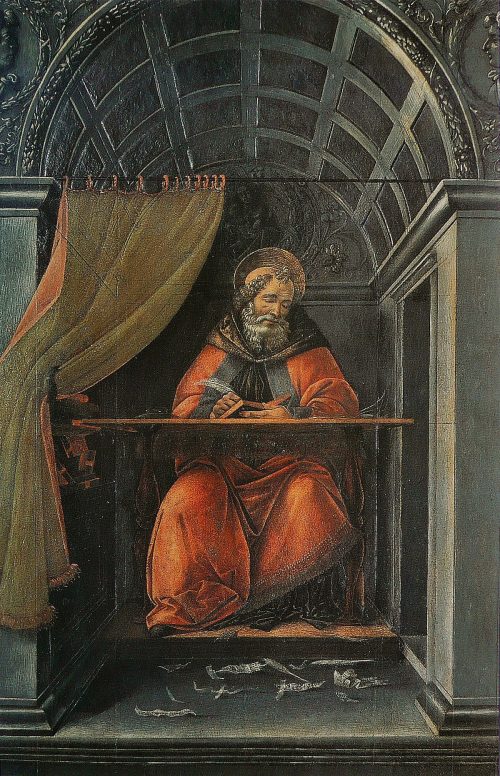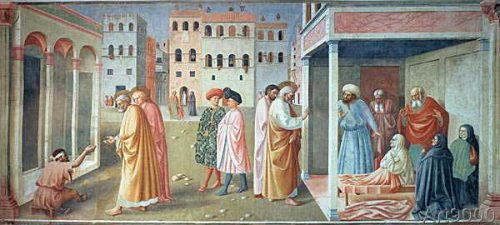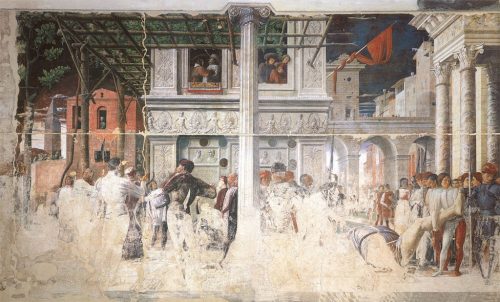Mantegna and the Concept of Total Illusion
Exhibition: Mantegna and Bellini
Date: March 21 – July 1, 2018
Venue: Fondazione Querini Stampalia | Venice, Italy

Room of the bride and groom,1470
The art of Andrea Mantegna (born c.1431, died 1506) has long maintained a broad and deep appeal. From the impressive illusionism of his earliest works to the narrative power of his mature paintings, Mantegna’s art remained vivid and heroic, dramatic and emotional. They are also painted in stunning detail: pebbles, blades of grass, veins, and hair are rendered with excruciating care, and he depicted even in his great narrative works the mundane particulars of earthly existence, showing laundry hanging out to dry and buildings fallen into disrepair. He had a deep interest in human nature and issues of moral character.

The Holy Family with St Elizabeth and the young St John, c. 1485-1488.
Tempera and gold on canvas, 62.9 x 51.3 cm. Kimbell Art Museum , Fort Worth.
Perhaps most strikingly, Mantegna’s pictures are filled with references to classical antiquity. No other painter of the fifteenth century so thoroughly understood and abundantly included in his art the costumes, drapery folds, inscriptions, architecture, subject matter, ethical attitude, and other aspects of ancient classical civilisation. And instead of the cool classicism of later centuries, his vision of Greco-Roman civilisation is lively and has a familiar and nostalgic air about it.
For him, antiquity was a near, palpable presence, one which he sought constantly to bring to colourful existence in his pictures. It is this thirst for a vanished classical past that places Mantegna most firmly in the context of his time, as his art was favoured most warmly by Renaissance contemporaries who shared his visionary quest to revive the moral strength and naturalism which marked the art of antiquity.

The Descent into Limbo, c. 1490. Tempera on panel, 38.2 x 42.3 cm.
Private collection.
Mantegna was a leader in the renewal of culture occurring during his time, a movement we call the Renaissance, or “rebirth.” In the fifteenth century, classical civilisation was a whole universe open to rediscovery. It offered an alternative to the confining, medieval world of scholastic thought and Christian theology. Classicism meant the liberation of the mind and the joys of literary study. The writers and artists of antiquity indulged freely in the delights of the material world, an attitude shared by Mantegna and many of his contemporaries.

Sandro Botticelli, St Augustine in his Cell, 1494. Tempera on panel, 41 x 27 cm.
Galleria degli Uffizi , Florence.
Renaissance men found spiritual ancestors from centuries past who had similar ideas about virtue and vice, and whose secular sensibility embraced a naturalistic art that was idealised in its formal perfection and its harmonious proportions. Mantegna painted his classical visions for enthusiasts, men and women who were dilettantes in the original sense of the word, delighting in their new discoveries. His life and works contributed to the air of celebration and self-congratulation characterising much of Renaissance culture.

Masolino, Healing of the Cripple and Raising of Tabatha, 1426-1427.
Fresco, 255 x 588 cm (full fresco). Brancacci Chapel, Santa Maria del
Carmine, Florence.
Some modern scholars avoid using the word “Renaissance” and, rather than see the period as being an age of confidence and a glorious rebirth of values, they describe Italian culture from 1400 to 1600 as one of conflicting interests, a hesitant and contradictory world in which the men and women cautiously “negotiated” their places in society. Period texts, however, reveal a mentality not as tentative and fearful as modern scholarship would have us believe.

Martyrdom of St Christopher, c. 1448-1457. Fresco. Ovetari Chapel,
Church of the Eremitani, Padua.
To be sure, the Renaissance had its political crises and social dislocations. It is important to bear in mind the larger picture: leading patrons, intellectuals, and artists in Italy felt they were living in a period of rebirth, and were forcibly helping to shape a new order of things. In the visual sphere, Renaissance writers about art – Lorenzo Ghiberti, Leon Battista Alberti, and Giorgio Vasari, for example – were quite clear in seeing the Middle Ages as a dark period, and their own age as one of enlightenment and human improvement. They looked back with admiration towards the achievement of the Greeks and Romans, and called for, not a bland imitation of antiquity, but an embracing of the ideals and values which made ancient societies superior to the cultural decline that followed: reason, an acceptance of natural law, and ethical moderation.
To get a better insight into the life and the work of Mantegna, continue this exciting adventure by clicking on: Mantegna, Amazon UK , Amazon US , Ebook Gallery , iTunes , Google , Amazon Australia , Amazon Canada , Renaud-Bray , Archambault , Les Libraires , Amazon Germany , Ceebo (Media Control), Ciando , Tolino Media , Open Publishing , Thalia , Weltbild , eBook.de , Hugendubel.de , Barnes&Noble , Baker and Taylor , Amazon Italy , Amazon Japan , Amazon China , Amazon India , Amazon Mexico , Amazon Spain , Amabook , Odilo , Casa del libro , 24symbols , Arnoia , Nubico , Overdrive , Amazon France , numilog , youboox , Decitre , Chapitre , Fnac France , Fnac Switzerland , ibrairiecharlemagne.com , Bookeen , Cyberlibris , Kobo , Scribd , Douban , Dangdang






























